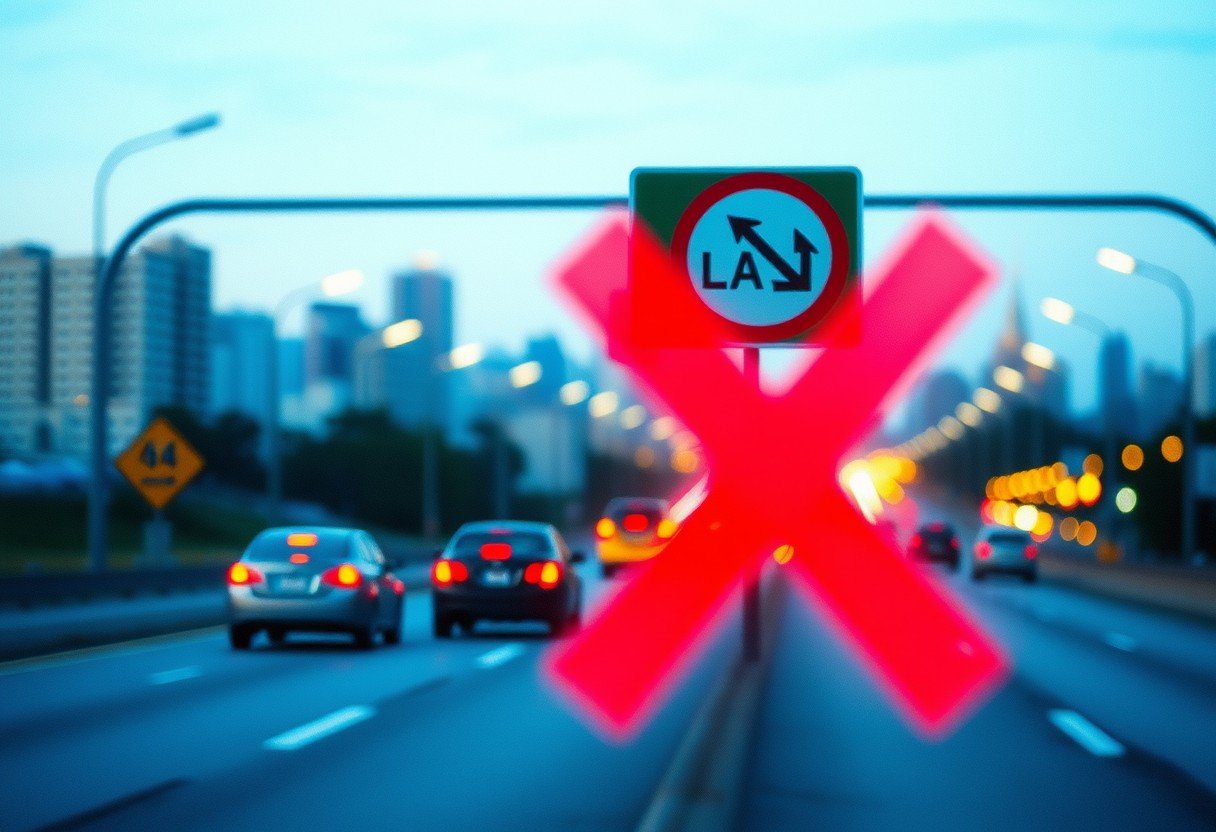Seeing a large, illuminated red “X” above a highway lane is a clear signal that you must avoid it. This traffic control system is used to close lanes for safety reasons, such as an accident, road work, or to manage traffic flow. Understanding the rules is essential for your safety and to avoid steep fines. This guide explains what the red “X” means, the rare exceptions for using the lane, and the penalties for ignoring this important signal.
What Does a Red X Over a Lane Mean?
A red “X” is a traffic control signal that explicitly means the lane is closed to traffic. When you see this sign illuminated over a lane, you are legally required to move out of it as soon as it is safe to do so.
The primary purpose of these signals is to enhance safety for everyone on the road. They are often used in reversible lane systems, on bridges, in tunnels, and in active work zones to protect emergency responders and construction crews from moving traffic.
Ignoring this signal is not only dangerous but also a traffic violation. It puts you, other drivers, and workers at significant risk of a serious accident. Think of it as the equivalent of a solid red light, but for an entire lane.
Are There Any Exceptions to the Rule?
While the rule is very strict, there are a couple of extremely specific situations where you might be permitted to enter a lane marked with a red “X”.
The most common exception is when you are directed to do so by a police officer or an official traffic controller on the scene. A human officer’s instructions always override automated signals. Another scenario is needing to briefly enter the lane to yield to an approaching emergency vehicle, like an ambulance or fire truck.
Some jurisdictions may have clauses for drivers with special permits, but this is very rare. For the vast majority of drivers, the rule is simple and absolute: if you see a red “X”, stay out of that lane.
What Are the Penalties for Driving in a Red X Lane?
Authorities take the misuse of a red “X” lane very seriously due to the high safety risks involved. The penalties are often much stricter than for a minor traffic infraction.
If you are caught driving in a closed lane, you can face a variety of consequences that impact both your wallet and your driving record. The severity can increase significantly if your action leads to an accident.
Potential penalties include:
- Hefty Fines: These can range from a couple of hundred to over a thousand dollars, depending on the state.
- Points on Your License: Accumulating points can lead to increased insurance rates and, eventually, a suspended license.
- Mandatory Traffic School: A judge may order you to attend traffic school at your own expense.
Repeated offenses can classify you as a high-risk driver, leading to drastically higher insurance premiums for years. The financial and legal troubles are not worth the few seconds you might save by illegally using a closed lane.
How to Safely Navigate When You See a Red X
Seeing a red “X” ahead requires you to take prompt and safe action. Panicking or making a sudden move can be just as dangerous as ignoring the signal. The key is to remain calm and practice defensive driving techniques.
When you notice a red “X” over your lane or a lane ahead, immediately begin planning to merge into an open lane. Do not wait until the last second. Use your turn signal well in advance to alert other drivers of your intention to move over.
Before changing lanes, always check your mirrors and your vehicle’s blind spot to ensure the way is clear. Adjust your speed to match the flow of traffic in the lane you are entering and merge smoothly. Maintaining good situational awareness is crucial for navigating these zones safely.
Do Red X Lane Rules Vary by State?
The fundamental meaning of a red “X” is consistent across the United States: the lane is closed. However, the specific penalties, such as the exact fine amount and the number of points added to your license, can vary significantly from one state to another.
For example, some states have specific laws that double the fines for traffic violations in construction or emergency zones, which often use red “X” signals. It is your responsibility as a driver to be aware of the local traffic laws wherever you are driving.
To avoid any confusion, always check the driver’s manual or the Department of Motor Vehicles (DMV) website for the state you are in. Ultimately, the safest and most legally sound strategy is to never drive in a lane with a red “X” under any normal circumstances.
| Violation | Potential Fine Range | Potential License Points |
|---|---|---|
| First Offense | $150 – $400 | 2-3 points |
| Second Offense | $300 – $750 | 3-4 points |
| Violation in a Work Zone | Fines May Double | Points May Increase |
Frequently Asked Questions
What should I do if I accidentally enter a lane with a red X?
If you find yourself in a lane with a red “X”, do not panic. Turn on your signal, check your surroundings, and merge into an open lane as soon as it is safe to do so. The key is to exit the closed lane safely and promptly.
Can I drive in a red X lane if traffic is very heavy and it looks clear?
No. You must not enter a lane with a red “X” regardless of traffic conditions or whether it appears clear. The lane is closed for a reason, which may be a non-visible hazard far ahead, and driving in it is a violation.
Is a yellow “X” the same as a red “X”?
A yellow “X” is a warning signal that the lane is about to close and will soon display a red “X”. If you see a yellow “X”, you should prepare to safely vacate the lane and should not enter it if you can avoid it.
Why are red X lanes used in tunnels?
Red “X” signals are crucial in tunnels to manage incidents. If there is a stalled vehicle, an accident, or debris, officials can quickly close the lane to prevent further collisions and allow emergency vehicles safe access to the scene.







Leave a Comment